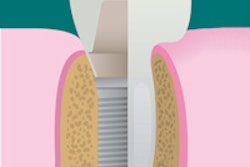
In the mind of a patient, cost can outweigh all other factors when treatment options are presented. Now, a new study by Swiss researchers can help clinicians better understand the cost-effectiveness of implant-supported single crowns (ISCs) compared to fixed dental prostheses (FDPs) when restoring a single missing tooth (Journal of Dental Research, December 2013, Vol. 92:12, pp. 183S-188S). The information can help clinicians guide patient decision-making.
"In general, we observed greater costs (amounting about plus 10%) in group 2 with fixed dental prostheses as compared to implant single crowns," Nicola Zitzmann, DDS, PhD, a professor in the department of periodontology, endodontology, and cariology at the University of Basel in Switzerland, explained in an email to DrBicuspid.com. "This difference was mainly related to higher laboratory fees. In both groups, costs varied slightly among patients due to individual needs for bone augmentation during implant placement or soft-tissue grafting in the pontic area."
While cost and a patient's suitability for either treatment are of the utmost importance, aesthetics also are given considerable weight when a patient selects a treatment plan presented by a clinician. A 2010 study gauging patients' willingness to pay found that most participants preferred implant treatment for missing anterior teeth, the researchers noted (Clinical Oral Implants Research, August 2010, Vol. 21:8, pp. 789-793). These factors are complicated by the payment options at the disposal of the patient, either through insurance or national healthcare programs.
“Implant treatment led to expected cost savings.”
colleagues, University of Basel,
Switzerland
"When the treatment decisions are guided by insurance directives, patients tend to claim the scheduled option without reflecting their individual needs," Dr. Zitzmann acknowledged.
Switzerland has a fixed tariff structure for dentists and dental technicians, but the researchers' conclusions can be reasonably applied to other treatment decision-making in other countries, according to Dr. Zitzmann. While prices "certainly differ among countries depending on the gross national product," she noted, "the proportions are comparable."
Both options have similar survival rates after five and 10 years: 94% and 90% for FDPs and 95% and 90% for ISCs, respectively. Costs differ in the areas of maintenance and initial treatment, but the researchers' main goal for the prospective preference trial was to compare long-term cost-effectiveness for each option for restoring a single missing tooth.
The treatments were all performed in dental postgraduate programs at the University of Basel. The study included 26 patients who agreed to the three-year recall period and were only excluded for general contraindications for implant surgery. Group 1 included 15 patients who selected ISC, while the 11 who selected FDP made up group 2.
The researchers tallied initial treatment costs and maintenance costs during scheduled or emergency recall visits. Patient perceptions were evaluated one month and one year after treatment.
During statistical analysis, the researchers calculated quality-adjusted tooth years (QATYs) and assigned values to the treatments. The average observation time for the ISC and the FDP groups were 51 and 49 months, respectively. The ISC group also had two unscheduled recalls to address a biological complication, palatal soft-tissue swelling in the fourth year, and a technical complication, an issue with a screw in the sixth year.
"According to the cost-effectiveness analysis, implant treatment led to expected cost savings ... irrespective of the time horizon and discount rate used in the model," the researchers wrote. This treatment also had a higher probability of being a preferred strategy regardless of the time horizon.
"We observed poorer estimations at baseline and greater improvements (after treatment) for the neighboring teeth in group 2 intended for FDP, compared to group 1 with ISC," Dr. Zitzmann explained.
Based on their analysis, the researchers found that ISCs were more likely to be cost-effective than FDPs at the three- and 10-year time horizons. The former also had "slightly higher QATYs," although both provided satisfactory long-term results in the view of the patients.
"We have to be aware that a single tooth implant may affect the adjacent teeth, which can end up in critical complication provided that these had been sound and pristine," Dr. Zitzmann cautioned. "On the other hand, an FDP offers the opportunity to change and potentially improve the appearance and integrity of discolored or largely filled adjacent teeth."
While ISCs were found to be the more cost-effective option in this particular situation, Dr. Zitzmann urged clinicians to actively educate their patients about treatment plans to help them make an informed decision.
"While both treatment options have clear indications, there are also situations in which ISC and FDP are recommendable," she wrote. "It is of utmost importance to include the patient in the decision-making process, and inform thoroughly about advantages and disadvantages, risks, possible complications, and maintenance issues. He or she should be able to participate in the decision and share the responsibility."



















